GPS when flying over the ocean

How can I see my location when flying over an ocean? I know that many airlines show you that on your screen, but I'm wondering if there's a way to do that on a phone, and without an internet connection.
Any OS is fine, Android, iOS, or even Windows Mobile.
I assume this won't be dangerous in any way as the phone would be on flight mode, and GPS is passive.
Best Answer
There are some things you have to be aware of. For example, you might think that it's enough to turn your GPS on, start your app, and see your position, as simply as that. Well, not really!
First of all, the plane shields from radio waves, so you are almost always forced to keep the phone next to (even against) the window to get your first fix. The farther you are from the window, the harder it is. After the first fix you can usually move a little, but it's hard to tell how much. Just try it. This means you'd better book a window seat.
Then, consider that there's a huge difference between a cold, a warm and a hot start. "Cold" means that your GPS has no idea where the satellites are, because you haven't used it in many days, so it must get the position of the satellites from the satellites themselves, and they transmit it slowly. When you have a data connection the phone can normally download the data from the Internet (this would be "Assisted GPS" or A-GPS), but on board a plane it's normally either not available or very expensive. So: when you are still on the ground, start your GPS app and wait until you have a fix. This will make everything faster (it's the so-called "warm" start).
One more disclaimer: for some reason the altitude measured by a GPS is not accurate at all. Once I compared it with the one shown by the plane's infotainment system, and the difference was more than 500 metres (!!!). It probably doesn't matter, but you might want to know it.
Now the bad part: GPS receivers can be very different from each other, and they can have unexpected problems.
- My first phone with integrated GPS used a receiver (SiRFstarIII) that was top-notch at the time (10 years ago!), and I think I managed to see my position 20% of the times. All the other times it was an eternal wait... The receiver was simply not good enough.
- Then I switched to a phone which used a NovaThor chip. For some reason I've never understood, it worked until the plane reached an altitude of 3950 metres, and then it suddenly stopped working. It had nothing to do with speed, it was just the height. I guess it was some kind of restriction put in place to avoid that the chip could be used to guide missiles, or something like that. Go figure. Anyway, if you happen to have a phone with such restrictions, you are out of luck. And I think the only way to find it out is trying.
- My current phone uses a Snapdragon 625 chipset, and guess what? Altitude is not a problem, but there are others! Quite often it "gets lost": for some reason you start seeing the altitude increasing very slowly (like a couple of metres every 10 seconds), until it finally hangs. Sometimes it helps to close the app and restart it, but it isn't guaranteed.
And all these phones have always worked perfectly when used in a car or on foot, which is what they are designed for. Apparently, the poor reception due to the plane's shielding, combined with the high speed and altitude, gives GPS receivers a hard time. And I don't think there's a way to know how good your GPS will work on a plane, apart from trying it.
Finally, the apps. On Android I use GPS Test. It's free, and it's great for getting the coordinates, altitude and speed, but it doesn't have maps. To see where I am I normally use TomTom with offline maps, which is also free as long as you don't use it to get directions. But obviously the maps don't cover the oceans, so you need something else.
Pictures about "GPS when flying over the ocean"



Does GPS work over the ocean?
The global positioning system (GPS) is commonly used on land and in the air to obtain position and timing information. However, the radio frequencies used by GPS cannot penetrate in seawater, requiring a different system for underwater positioning.Can I use GPS while flying?
Unfortunately the plane body does an excellent job of blocking GPS signal. In general if you're in a window seat you will be able to get a signal by holding the GPS near the window (or, for example, on a tray table) - but if you're elsewhere on the plane it's very unlikely you'll get a signal.Is there radar over the ocean?
There's No Radar Over The Middle Of The Ocean. Here's How Planes Keep From Hitting Each Other.How do planes navigate across the Atlantic?
Most aircraft cross the atlantic by GPS, usually with INS as backup. INS as the primary form of navigation is still used as well. Historically, a combination of dead reckoning and long range radio navigation systems were used on transatlantic routes.Why All Planes Take This Overcrowded Path Across The Atlantic Ocean - Cheddar Explains
More answers regarding gPS when flying over the ocean
Answer 2
I use maps.me for offline maps.
To be able to receive a GPS signal, I have to sit next to a window and push my phone against it. This sometimes works.
Answer 3
I've used both Here maps and maps.me on the airplanes. It seems Here has much wider coverage. While you can't download maps of oceans, you can still see the real globe when zooming out and know where you are. That's the most important point compared to maps.me (which only zooms out to a world map instead of a globe that you can rotate around)
If you have plenty of space you can download maps for all the continents and get a much more detailed map including a lot of sea areas
Below are some of it in action
Of course it'll be better if there's an offline Earth map. Unfortunately Google Earch doesn't support offline mode and the best you can do is viewing the area to cache it before the trip
Answer 4
While GPS is prohibited by many airlines, such as United, under a broader electronics ban, many/most travelers have GPS enabled inadvertently.
If you are one who has 'forgotten' to turn it off, any GPS app on the phone will give you a location...provided you can reliably receive the signals within the aircraft.
Also, you can see your location retroactively in many regions by using flight tracking services such as FlightAware.com.
Sources: Stack Exchange - This article follows the attribution requirements of Stack Exchange and is licensed under CC BY-SA 3.0.
Images: César Coni, O.Sha, O.Sha, Zekai Zhu


